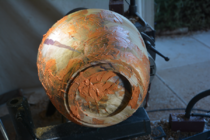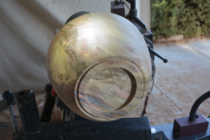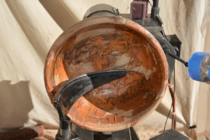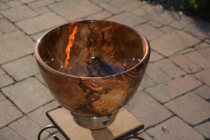Here in the desert SouthWest green hardwood is a rare commodity and you tend to take whatever you can get… defects and all. In addition I have learned that local wood with a lot of color & figure often needs some type repair when turned. All the cracks I am talking about occurred during drying – the wood was defect free when green and safe to turn.
For a few smaller voids sawdust & superglue works great and you don’t have to wait overnight to get to a final surface, but for big cracks or a large number of defects thickened epoxy is the way to go. You add a thickening agent (I use West Systems 404 powder) to get the epoxy to a consistency of drywall spackle and just fill cracks/voids like you would repair drywall. Add color with dyes, pearlescent powders and/or glitter – let dry overnight then turn away the excess.
Here is a rough turned blank – pepper tree of some kind from a neighbors yard. Wood moved a lot when it dried resulting in lots of cosmetic defects but also 2 big structural cracks that must be dealt with before it is safe to put back on the lathe.
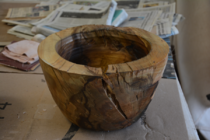
Sidewall crack has been repaired with epoxy colored with transparent yellow dye so you can see through the crack when complete. I have had best luck sealing wood for poured epoxy with clear packing tape that has a bead of hot melt glue around the perimeter sealing tape to the bare wood. Next step is to fill the bottom defect with another pour of colored epoxy.
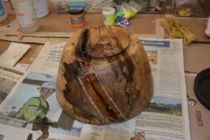
Outside turned to final shape – time to repair all the surface cracks/voids…
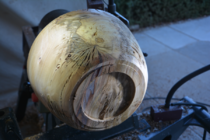
Thickened epoxy is made opaque by the thickening agent so you might as well go with the vibrant colors of opaque dyes and pearlescent powders - here I chose orange. To stir/apply epoxy I use a wood tongue depressor with the rounded end trimmed off – by in bulk for next to nothing and toss when they get gunked up.
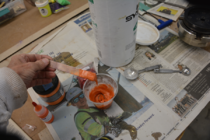
For a few smaller voids sawdust & superglue works great and you don’t have to wait overnight to get to a final surface, but for big cracks or a large number of defects thickened epoxy is the way to go. You add a thickening agent (I use West Systems 404 powder) to get the epoxy to a consistency of drywall spackle and just fill cracks/voids like you would repair drywall. Add color with dyes, pearlescent powders and/or glitter – let dry overnight then turn away the excess.
Here is a rough turned blank – pepper tree of some kind from a neighbors yard. Wood moved a lot when it dried resulting in lots of cosmetic defects but also 2 big structural cracks that must be dealt with before it is safe to put back on the lathe.

Sidewall crack has been repaired with epoxy colored with transparent yellow dye so you can see through the crack when complete. I have had best luck sealing wood for poured epoxy with clear packing tape that has a bead of hot melt glue around the perimeter sealing tape to the bare wood. Next step is to fill the bottom defect with another pour of colored epoxy.

Outside turned to final shape – time to repair all the surface cracks/voids…

Thickened epoxy is made opaque by the thickening agent so you might as well go with the vibrant colors of opaque dyes and pearlescent powders - here I chose orange. To stir/apply epoxy I use a wood tongue depressor with the rounded end trimmed off – by in bulk for next to nothing and toss when they get gunked up.


